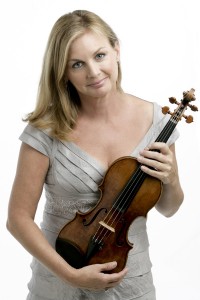USC professor organizes LACO program
The Los Angeles Chamber Orchestra will host the first of five “Baroque Conversations” concerts today. This is the first time the winter series will begin before the new year. USC Thornton professor and violinist Margaret Batjer helped organize the series in her capacity as concertmaster of LACO and will also perform in it. Though Batjer said this year’s music is not holiday-themed, the nature of Baroque music lends itself well to a December performance.

First chair · USC Thornton professor Margaret Batjer enjoys baroque music for its joyous and celebratory tone, which is perfect for the holidays. – Photo courtesy of Margaret Batjer
“Personally I think all Baroque music reminds me of something celebratory and … very joyous and happy,” she said.
Currently in its eighth year, the Baroque Conversations series features music from the pre-classical period of the 1600s through the time of legendary composer Johann Sebastian Bach. The theme of this year’s series is Baroque variations and in her selection of pieces, Batjer said she wanted to find works that highlight the three different types of Baroque music: chiacona, passacaglia and folia.
“There’s an enormous amount of research that goes into finding the right music,” Batjer said. “The playing part is the easy part. When they asked me to design this program I kept in mind that I was the first one of the group. I wanted our audience to have the table set for the series that’s coming and so I wanted to include a lot of these variations.”
Batjer said that baroque composers are known for their prolific works. One composer featured in the concert, Scarlatti, wrote more than 550 keyboard sonatas — three of which will be performed.
Batjer said she was always jealous that Scarlatti had composed so many keyboard sonatas and so few for violin, so she decided to play a keyboard sonata on her violin.
“The Scarlatti sonatas are extremely colorful and festive and I specifically chose Scarlatti because he’s very close to my heart,” Batjer said. “Playing them on violin was always something I wanted to do and they lend themselves well to a solo instrument.”
The concert will features six performers, in addition to Batjer: bass player Nico Abondolo, cellist Armen Ksajikian, keyboardist Patricia Mabee, violinist and assistant concertmaster Tereza Stanislav and John Schneiderman playing lute and Baroque guitar. Batjer said she enjoys working with the small group and it provides a much different experience than being part of a large orchestra.
“I’m really looking forward to working with my colleagues again in the ensemble,” Batjer said. “It’s a very small group where we can all really have the time to work in detail and explore different options of how to play the different pieces.”
Batjer also appreciates that the nature of the performance itself allows performers to communicate with the audience. Zipper Concert Hall in Downtown Los Angeles, where the performance is held, seats approximately 500 patrons and the Conversations series is unique in that it features no intermission but the music is interspersed with conversations about music and performance practice. The program also features a Question & Answer session that allows the audience to converse with performers.
“I love the intimacy of it,” Batjer said. “It’s a very special hall because people feel very much a part of the music. It’s not a humongous concert hall where people feel disconnected from the performers. By mixing talking and playing it makes people more comfortable and more open to hearing music in a different way.”
Batjer, who joined the USC faculty in 2005, said that performances such as the Baroque Conversations Series have helped her become a better teacher and teaching has also improved her performance.
“I lead two different lives, one as a performer and one as a teacher,” she said. “But they are very much interwoven. I’m always learning. I learn from performances things that I can pass on to my students but I also learn from teaching. Having to explain things to students helps me solidify more my own musical and technical choices in my own playing. I think they complement each other and there’s a really natural connection between the two.”
